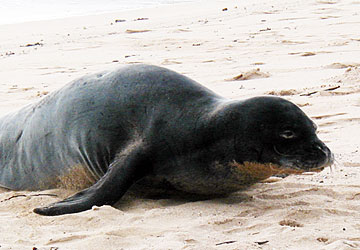A SEAL'S-EYE VIEW

STAR-BULLETIN / JANUARY 2005
|
|
Endangered monk seals star in National Geo special
A National Geographic special follows animals fitted with videocameras into their ocean habitat
Critically endangered Hawaiian monk seals will star in their own National Geographic special tomorrow night on public television.
"Hawaiian Monk Seals: Surviving Paradise" is a chance for the charismatic marine mammals to take viewers with them into the ocean depths of the Northwestern Hawaiian Islands as they forage for food, evade predators and have some fun.
PROGRAM AIRS TOMORROW
» National Geographic's "Hawaiian Monk Seals: Surviving Paradise" airs 9-10 p.m. tomorrow on Hawaii Public Television.
» Free video podcasts shot by seals with Crittercams on their backs are available at www.nationalgeographic.com/podcasts, on iTunes and Yahoo!
|
Much of the hourlong show will be footage gleaned from a cooperative project that outfitted 42 of the animals with Crittercams® -- compact video cameras designed to be worn by wild animals.
Between 1995 and 2002, a total of 69 hours of video footage was recording during Crittercam® taping sessions that lasted from five days to two weeks.
The cameras recorded only when seals were in the water, said Frank Parrish, a habitat ecologist who worked on the project for the protected-species division of NOAA's Pacific Islands Fisheries Science Center.
Parrish said scientists learned by watching seal-based video that the animals:
» Dive as deep as 500 meters and can hold their breath at least 17 minutes.
» Take 5- and 10-minute naps in underwater caves.
» Flip large rocks on sandy bottoms to flush out fish hiding underneath.
» Have to compete for their food with large and hungry ulua.
» Dine on a wide variety of crustaceans, squid, octopus and fish.
The seals live only in Hawaii and are most populous in the remote Northwestern Hawaiian Islands.
Because the body of the Hawaiian monk seal has remained virtually unchanged for more than 15 million years, they are sometimes called "living fossils." But while they've stayed the same, apparently something in their environment is changing, putting their survival in serious jeopardy.
Though their habitat has been protected since 1976, the seals' current population is estimated at 1,200 animals -- the lowest since people started keeping track, said Bud Antonelis, chief of the protected-species division of the National Oceanic and Atmospheric Administration's Pacific Islands Fisheries Science Center.
"During the last five years, the population is declining at about 4 percent per year," Antonelis said.
At that rate, the numbers are expected to drop below 1,000 in the next five years -- and the long-term prospects for the seals is not good.
Over the past five years, only one in five monk seals survives to sexual maturity, Antonelis said.
The key problem seems to be that they aren't getting enough to eat.
Scientists had speculated that perhaps the "crash" of the lobster fishery in the Northwestern Hawaiian Islands in the 1990s contributed to the seals' decline. But there's no real evidence that the shortage of lobsters is the problem, because monk seals are opportunistic feeders, Antonelis said.
"Because the species is in a crisis situation, we must do everything we can to enhance their recovery," Antonelis said.
Among the efforts:
» Continuing removal of marine debris from the Northwest Hawaiian Islands. Entanglement in drifting nets is one cause of seal deaths.
» A "captive care" program, to give young seals added protection and extra food in their crucial first few years. Twin seals born at Midway Atoll are two of the current participants in the program.
» Selective removal of sharks that prey on still-nursing monk seal pups.
» Continued research on changes in the ocean's productivity and competition between seals and other predators for the same food.

